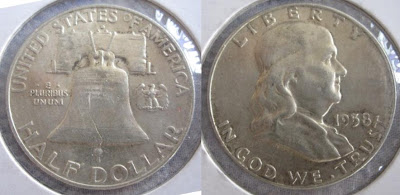The US half dollar has a diameter of 30mm, that is the size of the Nehru 5 rupee coin or British India silver rupee coins. The coins shown below on this page are all silver coins and the these would be worth about 300-350 rupees each on metal value alone as per their size and weight.
Franklin Half dollar, 1958
 The "Franklin Half" is a coin of the United States, minted from 1948 to 1963. The coin pictured Benjamin Franklin on the obverse and the Liberty Bell on the reverse. A small eagle to the right of the bell was necessitated by law; ironically, Franklin himself had opposed the selection of the eagle as the US national symbol, preferring the turkey as a "more noble bird". A bill rushed through Congress after the assassination of John F. Kennedy caused the Franklin half to be replaced by the current Kennedy half dollar in February 1964, nine years before the design would otherwise have been eligible for a change.
The "Franklin Half" is a coin of the United States, minted from 1948 to 1963. The coin pictured Benjamin Franklin on the obverse and the Liberty Bell on the reverse. A small eagle to the right of the bell was necessitated by law; ironically, Franklin himself had opposed the selection of the eagle as the US national symbol, preferring the turkey as a "more noble bird". A bill rushed through Congress after the assassination of John F. Kennedy caused the Franklin half to be replaced by the current Kennedy half dollar in February 1964, nine years before the design would otherwise have been eligible for a change.This half dollar coin was minted for 9 years, and probably circulated for a little over 10 years as in 1965, the metal for minting the coin was changed from silver to nickel because of the rising silver prices. So people would have kept the silver half dollar with them instead of spending it, and this may be a reason that a large part of the surviving Franklin half dollars and 1964 Kennedy silver half dollars are in good condition. The coin shown above is in BU condition.
Walking liberty half dollar, 1945

The Barber half dollar, though very widely used in circulation, had quite an unpopular design. So a redesign program was started by the then president Theodore Roosevelt for new coinage, as a result of which new coins like the mercury dime or the walking liberty half dollar shown above came into circulation. Many people, including myself, consider the obverse of this coin to be the most beautiful and most well designed silver coin to be circulated in the US.
Barber Half dollar, 1905

In 1897, the then US mint director James Kimball submitted his report that the time was due for a redesign of the circulation coins. Some 10 eminent designers were asked to give their designs, but they asked for a preposterous amount for the work. So, the next step was a contest open for the general public for the design. As it is, none of the submitted designs proved to be satisfactory and were rejected. Enter Charles E. Barber, who was given the task of making designs for the new coins. Thus started the series of Barber quarters and dimes, and also the Barber half dollar shown above.
I know what you are thinking now. Why have I put up such a worn out coin here on my site? The fact is, the Barber half and quarter dollars are a conditional rarity, which means that it is very hard to find in higher grade or condition. A Barber half in XF condition would definitely be very rare in XF condition and even in VF condition, it is still quite a valuable coin. I rate the coin shown above as being in VG condition, and i paid 10$ for this one(that is 20 times the face value). The reason for the poor condition is that the Barber series coins were very heavily used in circulation so are highly worn out. This is especially true for the Barber half dollar. From a lot of Barber half dollars, about 85% are expected to be below F condition, and as many as 40% to be below G condition. Thats how worn out these coins are.
The obverse shows the Liberty head with a cap and wreath. This was inspired from ancient Greek and Roman styles. The word 'LIBERTY' appeared on the headband in incuse . The reverse shows an eagle carrying a banner which reads 'E. PLURIBUS UNUM' meaning from many, one. The 13 stars above the eagle represent the original 13 American colonies. In a coin with this much wear and tear, that is not visible.
P.S. If you are a newbie and have trouble with the terminologies on the condition, you can have a look at my article on Coin Grading



No comments:
Post a Comment